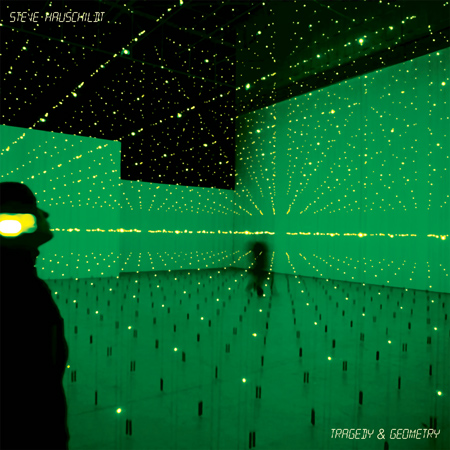Back in June, we favorably reviewed House, an inviting album of cosmic ambiance brought to you by Emeralds explorer John Elliott and longtime collaborator Sam Goldberg. Now it’s fellow Emeralds member Steve Hauschildt’s turn to step up to the plate, and he’s aiming for a home run with this hour-long release for Chicago’s much venerated Kranky label.
This is not Hauschildt’s first solo venture, but it sure feels like it. His earlier efforts, such as 2008’s The Summit and 2009’s Critique of the Beautiful, were largely droning epics that experimented with atonality and non-music. Compared to those releases, Tragedy & Geometry sounds downright poppy; there’s a palpable concern with melodicism and structure here that rivals not his prior solo work but rather that of Emeralds proper, and listeners pining for the followup to Does It Look Like I’m Here? will find these songs (yes, songs) warm and familiar.
Now, “warm” and “familiar” might seem like ill-fitting adjectives for an album described by its press release as “an ambiguous but subtle reference to Melpomene (Muse of Tragedy) and Polyhymnia (Muse of Geometry), or more specifically the collision/overlap of what they invoke” and “a treatise on the idea that technology is becoming more disposable as it’s becoming more accessible, and how this circumstance has a more evident/direct effect on the interpersonal, i.e. relations, with others in the so-called ‘Age of Information.’” But the differences between Hauschildt’s conception of the “Age of Information” on this album and that displayed on the 2009 Emeralds track “Alive in the Sea of Information” indicate that he’s grown increasingly comfortable with the realities of digital modernism: Tragedy & Geometry is not a polemic but rather a paean to this idea.
While “Polyhymnia” (the opening track) and “Music for a Moiré Pattern” offer the kinds of billowing arpeggios you’d expect from an Emeralds member, other moments call to mind different, sometimes unexpected reference points. With its jaunty beat and catchy tune, “Batteries May Drain” sounds like the backing track for some long-lost “Georgia”-era Orchestral Manoeuvres in the Dark production. “Allegiance,” meanwhile, sounds more in line with Emeralds releases like What Happened, but plays with texture and aural depth in a less somber context, enveloping the listener in thick, soothing drones. And “Blue Marlin” is simply gorgeous, seeming to take its cues more from the unapologetically new-age missives of Iasos than from the Kosmiche cosmonauts of 1970s Berlin.
Much like House, this album is more accessible than most of Emeralds’ output. Whether this turn towards the pretty is simply a one-off or the beginning of a new, more melodic direction in his solo career, Tragedy & Geometry proves that Steve Hauschildt is unafraid to paint in clear and vivid hues. Some might lament the lack of tension in this album, but when the music’s this beautiful, who needs it?

